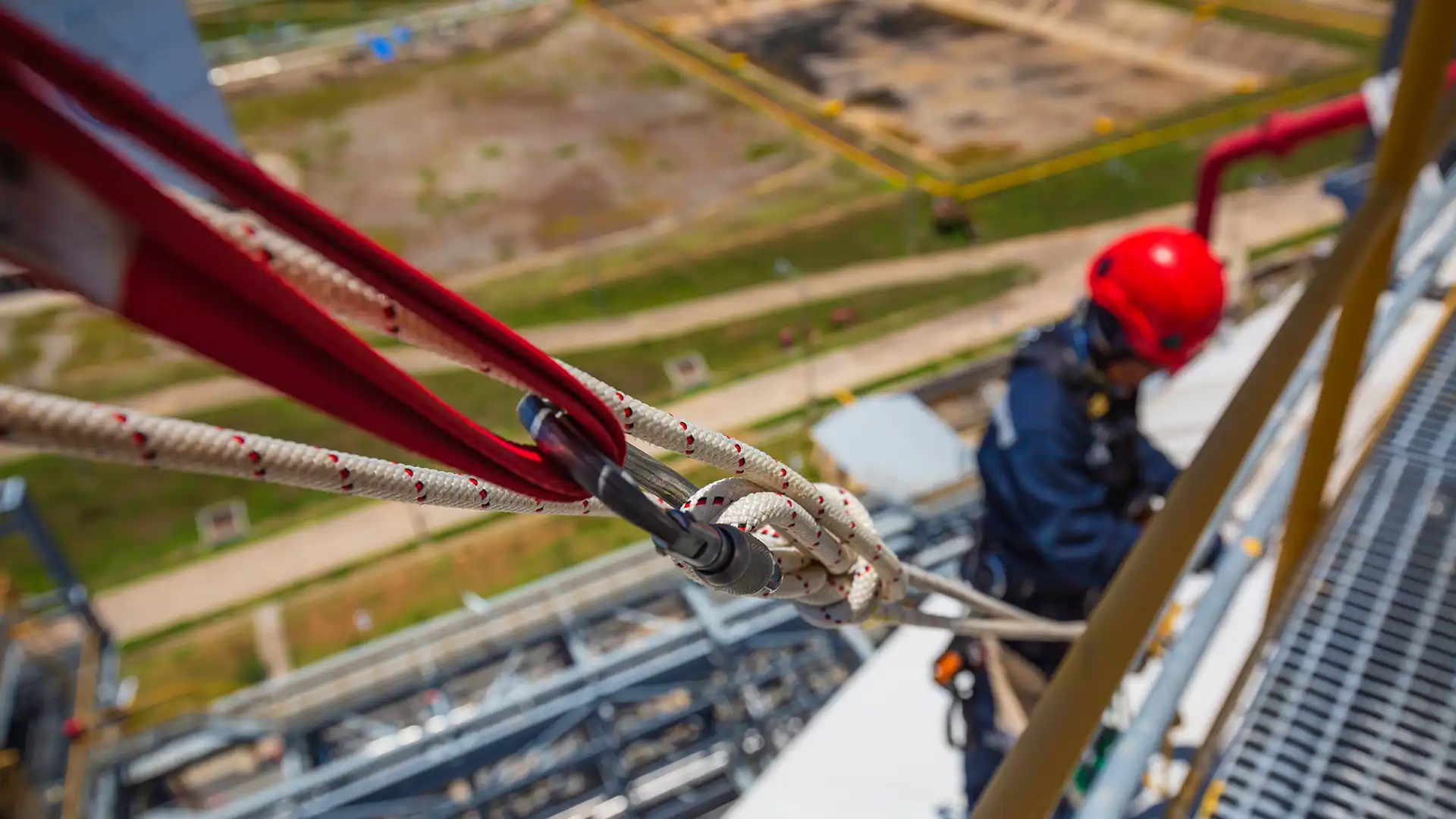A lanyard is a critical safety equipment that plays a vital role in protecting workers from fall risks during high-altitude tasks. Used across various industries, from construction sites to the energy sector, telecommunication towers to industrial facilities, lanyards are designed to meet work safety standards. EKS Work Safety aims to maximize worker safety with its high-quality lanyard models.
What is a Lanyard?
A lanyard is a flexible rope or strap system that connects a worker’s safety harness to a fixed anchor point during high-altitude work. It is designed to prevent falls or safely stop a worker during a fall. Typically made from durable materials such as high-strength polyester or polyamide, lanyards are both lightweight and long-lasting. EKS Work Safety’s lanyards are manufactured in compliance with international standards (EN 354 and EN 355) and are designed to withstand challenging working conditions.
Lanyards are generally designed with one or two ends. Single legged lanyards are used in fixed work areas, while double leg lanyards provide continuous connection in tasks requiring movement. Models with energy absorbers reduce the sudden force experienced during a fall, minimizing the impact on the worker’s body. This feature is critical in preventing serious injuries.
Types and Features of Lanyards
Lanyards are designed in various types depending on the purpose and work environment. EKS Work Safety offers a wide range of lanyards to provide solutions tailored to every need. The main types of lanyards include:
- Single Legged Lanyard: Ideal for workers in fixed positions. Typically used in tasks requiring minimal movement.
- Double Leg Lanyard: Provides two independent connection points, ensuring workers remain continuously connected while transitioning between points. Enhances safety in mobile tasks.
- Energy Absorbing Lanyard: Absorbs the energy generated during a fall, reducing the impact on the body. Mandatory for workers operating above 3 meters.
- Retractable Lanyard: Automatically retracts, increasing freedom of movement and preventing excess rope from tangling.
Lanyard Applications
Lanyards are indispensable in industries requiring high-altitude work. EKS Work Safety provides lanyard models tailored to the needs of different sectors, ensuring worker safety. Key application areas include:
- Construction Industry: Lanyards protect workers during facade work on tall buildings, scaffolding assembly, and roof repairs.
- Energy Sector: Insulated and durable lanyards are used for workers on high-voltage lines, wind turbines, and solar energy systems.
- Industrial Facilities: Lanyards are employed in maintenance and repair tasks on factory roofs, pipelines, or high platforms.
EKS Work Safety designs lanyard models specific to each industry, addressing unique requirements. For instance, lanyards with electrical insulation properties are preferred in the energy sector, while heavy-duty models stand out in construction.
Importance of Energy Absorbing Lanyards
Energy absorbing lanyards enhance worker safety by dissipating the sudden force generated during a fall. The high speed and force caused by gravity during a fall can cause serious injuries. Energy absorbers distribute this force, reducing the risk of injury. EKS Work Safety’s energy absorbing lanyards are made from high-quality materials and optimized for fall distances. For example, a longer energy absorber is preferred for a technician working on a tall wind turbine, while a shorter model may suffice for a construction scaffold.
How to Choose the Right Lanyard?
Lanyard selection should be based on the risks of the work environment and the nature of the task. An incorrect choice can compromise safety and reduce equipment effectiveness. EKS Work Safety recommends considering the following factors when selecting a lanyard:
- Work Height and Fall Distance: The lanyard’s length must be suitable for the working height. A lanyard that is too short restricts movement, while one that is too long increases fall distance.
- Material Quality: High-strength materials like polyester or polyamide ensure durability and longevity.
- Energy Absorber Feature: Energy absorbing lanyards are essential in high-risk fall areas.
- Industry Suitability: Models specific to industries such as construction, energy, or telecommunications should be selected.
How to Use a Lanyard?
Using a lanyard is straightforward, but every step must be carefully followed for safety. Before each use, the equipment should undergo visual and physical inspections. Ensure the anchor points are secure and carabiners are locked.
When using a double leg lanyard, ensure both connection points are used sequentially and correctly during transitions. The energy absorber must be undamaged and properly oriented to ensure the system’s safe operation.
Advantages of Lanyard Use
Lanyards stand out for the safety benefits they provide in high-altitude work. EKS Work Safety’s lanyards are distinguished by the following features:
- Continuous Connection: Double leg lanyards ensure workers remain connected to an anchor point at all times.
- Freedom of Movement: Ergonomic designs allow workers to move comfortably.
- Durability: High-strength materials ensure long-term use in harsh conditions.
- Easy Inspection: Transparent coatings make it easy to check the condition of energy absorbers.
These advantages demonstrate that lanyards are not just safety equipment but also tools that enhance work efficiency. EKS Work Safety prioritizes both the safety and comfort of workers at height with these features.
Take Safety a Step Further with EKS Work Safety
Every industry has unique safety needs, but the common requirement for high-altitude work is clear: a secure connection and a reliable system. A lanyard is the unseen yet critical component of this system. If you want to ensure safety without compromising control during high-altitude work, contact us for the right solutions.
You can visit our LinkedIn page for more.



 by
by